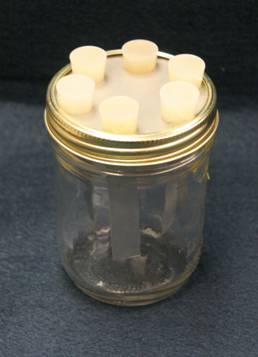Reactor Theory and Practice
Students wishing to study biofilms in the field or laboratory have a wide selection of methods for collecting them, and if so desired, returning them to the lab. The accompanying collection of exercises gives examples of how to collect biofilms from soil (Exercise 5 - Collecting Soil Biofilms by the Buried Slide Technique, and Exercise 16 - Isolation of Biofilm Populations from Soil Crumbs by Flotation), Water (Exercise 11 - Henrici's Microbial Fishing Technique) and cheek cells (Exercise 18 - Buccal Epithelial Cells with Adherent Bacterial Cells Revealed by Negative Staining) for example. Although these methods are fine for examining naturally occurring Biofilms they were produced under conditions that are not under the control of the student. In order to try to grow consistently uniform Biofilms for classroom or independent research one must employ some type of reactor. Reactors are devices used to control at least some of the many variables, which contribute to the formation of a biofilm. Even using a biofilm reactor, it is not usually possible to control all, relevant variables and no one type of reactor will “model” all conditions under which biofilms grow. Nevertheless engineers and microbiologists have devised a number of reactor types that reproduce many of the natural conditions under which biofilms grow. So, one reactor is not necessarily better than another, they are intended to model different habitats.
This introduction to reactor theory and practice is intended to help you to select the type of reactor which best suits the investigation you are contemplating and give you some pointers on how to construct, and maintain the reactor during biofilm development. Some theory is included to help make sense of the properties of the various types of reactors
Why use a reactor?
Reactors permit the controlled development of a biofilm so that in replicate trials, rather consistent biofilm samples are produced to that the measurements of such parameters as biofilm mass, thickness, metabolic activity, cell number and resistance to chemical or physical challenge can be made.
Reactor systems can be established that permit investigators (that’s you) to control many experimental variables including1:
- Chemical variables:
- Substrate type (sugars, proteins, lipids, etc)
- Substrate (nutrient) concentration
- Ph
- Inorganic components, (nitrogen and sulfur source etc.)
- Dissolved Oxygen
- Growth Inhibitors (antimetabolites, disinfectants)
- Physical variables
- Temperature
- Fluid shear stress
- Surface composition and texture (hydrophobic, hydrophilic, rough, smooth)
- Hydraulic residence time
- Biological
- Organism type (pure or mixed culture)
- Organism concentration
What sorts of reactors are there?
In the early days of biofilm research, commercial reactors were available from a limited number of suppliers and those that were available were very expensive. Investigators like Bill Characklis, Barry Pyle and Gordon McFeters2 improvised using Mason jars ® and other readily available materials as reactor vessels. Today, commercial reactor types are readily available but they are still very expensive.

constructed from a Mason Jar
In this collection we will revert to the fields infancy and provide instructions for building inexpensive but serviceable reactors from readily available materials, many of which you have in the lab already.
In their classic opus on biofilms, Characklis and Marshall describe three general types of biofilm reactors, 1. Batch reactors, 2. Continuously Stirred Tank Reactors and 3. Plug Flow reactors1. Each of these has special properties, advantages and disadvantages and each can be configured in a variety of ways in order to mimic specific growth requirements or natural habitats the investigator wishes to model.
